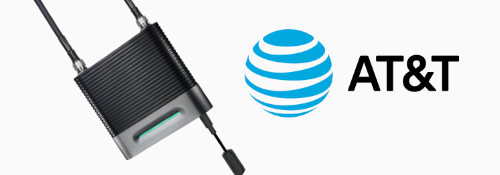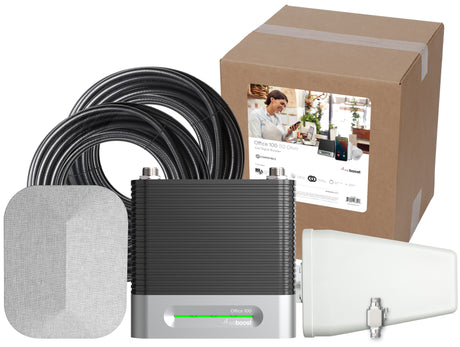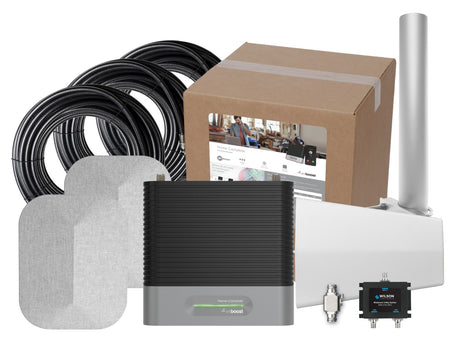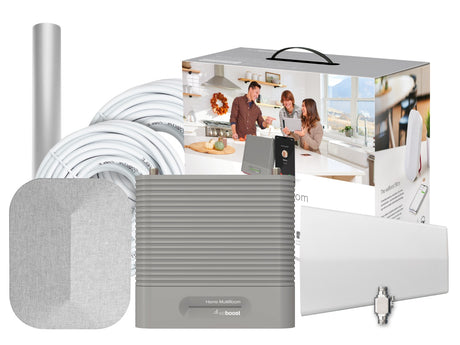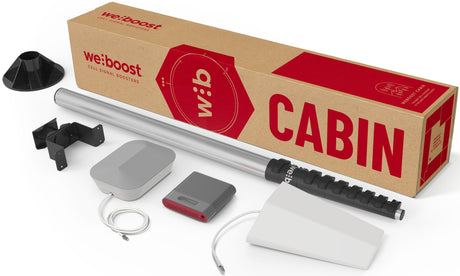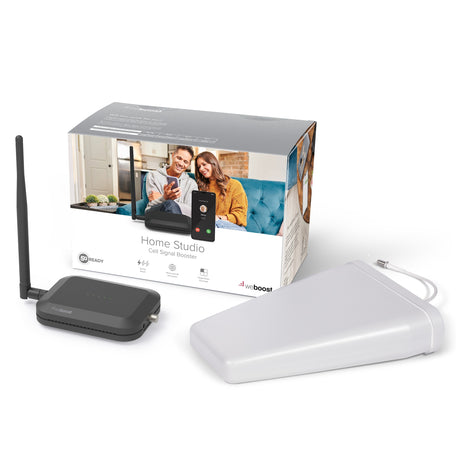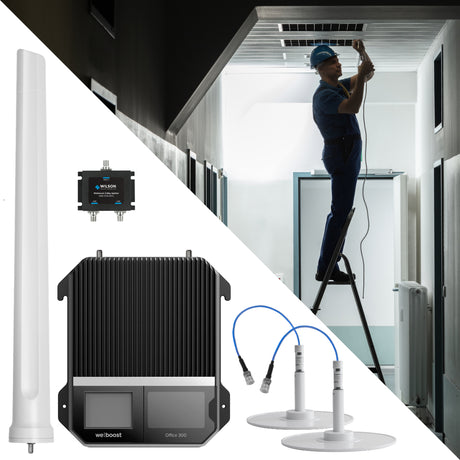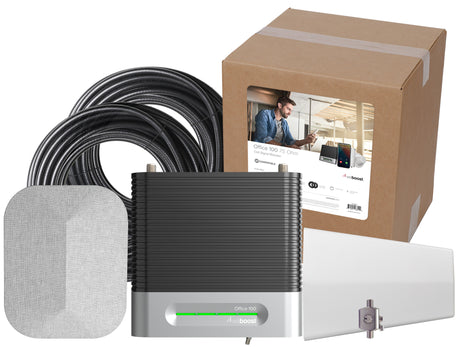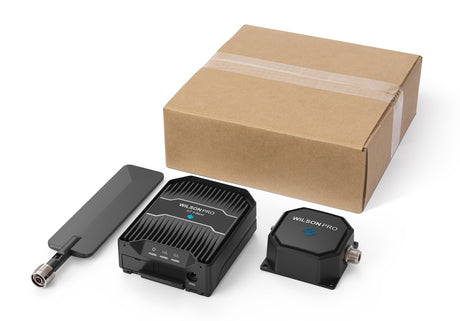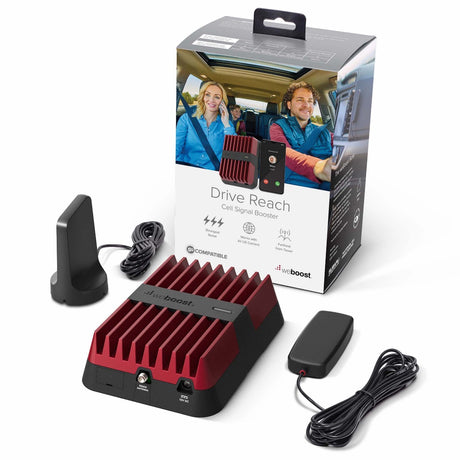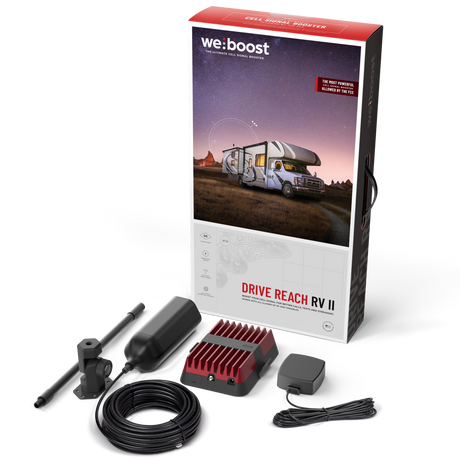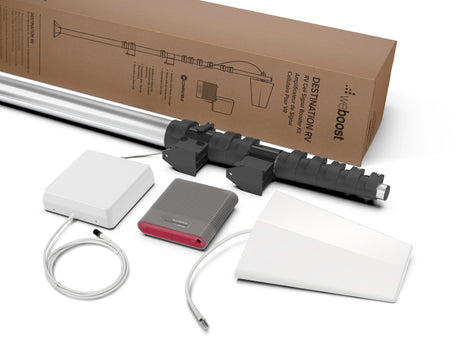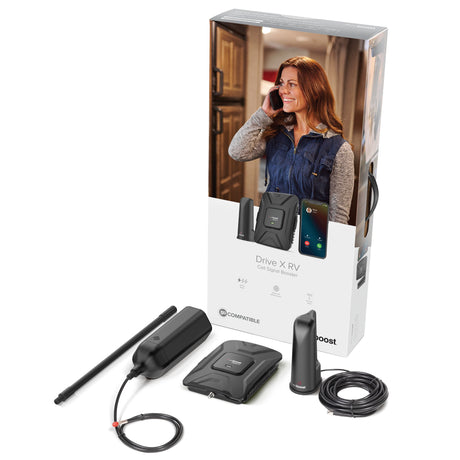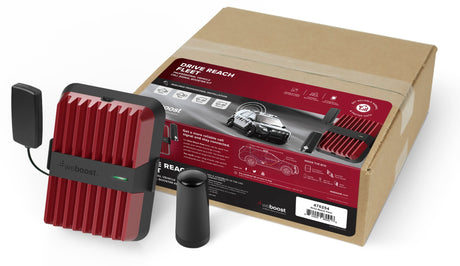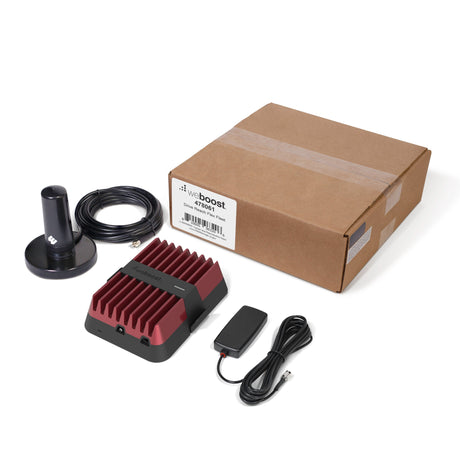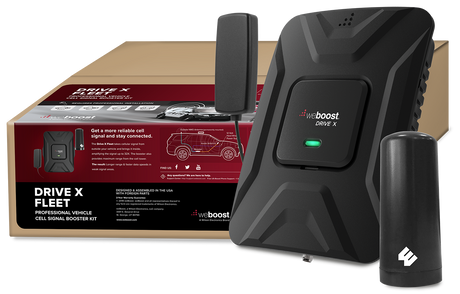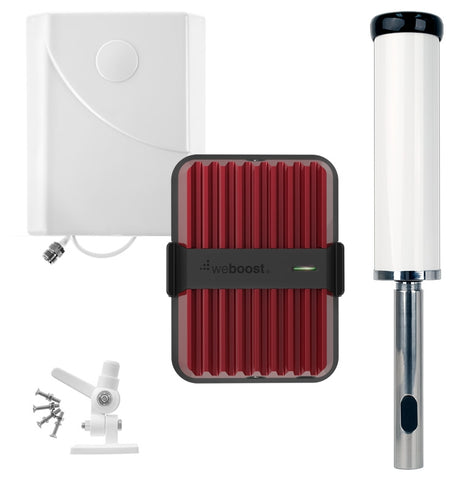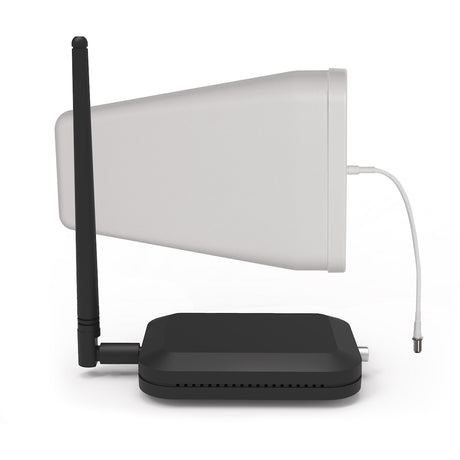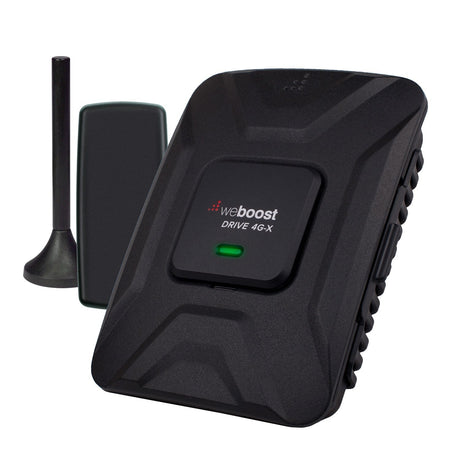Get strong cell signal in every part of your house with a cell phone booster for your whole home. Install it yourself or have a professional do it for you.
Solutions for Your Home or Office:
Whole Home Boosters Multiple Room Boosters Single Room Boosters Business Boosters Professionally-Installed Boosters IoT BoostersSolutions for Your Vehicle:
Car & SUV Boosters Overland Boosters Pickup Truck Boosters RV Boosters Semi Truck Boosters Fleet Vehicle Boosters Marine BoostersWhole Home Signal Boosters
-
weBoost Installed | Home Complete - Includes Professional Installation (474445)
$1,499.99Unit price /Unavailable -
-
-
Multiple Room Signal Boosters
Midsize boosters designed to cover multiple rooms with strong signal.
Single Room Boosters
Entry-level boosters designed to cover a single room with strong signal.
Business Signal Boosters
Keep your customers happy and employees connected with clear calls and fast internet, even during emergencies.
-
weBoost Installed Office 300 - Includes Professional Installation | 479047
$3,799.99Unit price /Unavailable -
-
-
-
Professionally-Installed Signal Boosters
Get the best possible performance by having the experts install your signal booster for you
-
weBoost Installed | Home Complete - Includes Professional Installation (474445)
$1,499.99Unit price /Unavailable -
weBoost Installed Office 300 - Includes Professional Installation | 479047
$3,799.99Unit price /Unavailable
IoT Signal Boosters
Perfect for setups that need reliable machine-to-machine connections, like security systems, ATMs, vending machines, EV chargers, and more.
-
WilsonPro IoT 3.0 Direct-Connect Cellular Signal Booster for IoT Devices and Modems | 460079
$799.99Unit price /Unavailable -
Car & SUV Signal Boosters
Stay connected while traveling. Perfect for daily commutes or rural road trips.
-
-
weBoost Dash Mobile Signal Booster with Built-In Wireless Charging | 471082
$199.99Unit price /Unavailable -
Overland Signal Boosters
Choose our trucker antenna for added boosting or our magnet mount antenna for an easy installation.
Pickup Truck Signal Boosters
Choose our trucker antenna for added boosting or our magnet mount antenna for an easy installation.
RV Signal Boosters
Boost your cell signal while driving or stopped. Stay connected anywhere you camp.
Semi Truck Signal Boosters
Easy to install in your cab and keep you connected anywhere on the road.
Fleet Vehicle Signal Boosters
Get reliable communication and precise tracking for your fleet vehicles.
Boat & Marine Signal Boosters
These boosters are built to tackle marine conditions, ensuring your calls, texts, and internet remain reliable and fast.
Certified Refurbished Boosters
Get like-new performance at a reduced price. Boosters are rigorously tested and guaranteed for 1 year
-
weBoost Drive Reach Mobile Signal Booster Kit | 470154R (Certified Refurbished)
$397.99Unit price /Unavailable -
weBoost 470144R Home MultiRoom Signal Booster (Certified Refurbished)
$437.99Unit price /Unavailable -
weBoost 470166R Home Studio Signal Booster Kit (Certified Refurbished)
$199.99Unit price /Unavailable -
weBoost 475021R Drive X Vehicle Signal Booster (Certified Refurbished)
$239.99Unit price /Unavailable
Enhancing AT&T Wireless Cell Signal with Signal Boosters
Ever had your phone call drop at the worst possible time? Maybe during a call to wish someone a happy birthday, or while finalizing plans over the phone? You're not alone. Many AT&T customers and mobile users everywhere often struggle with cell signal problems. But why is a strong and reliable signal so important anyway?
In today's fast-paced world, staying connected is not just a convenience—it's a necessity. Whether you're calling home, setting up work meetings, or even contacting emergency services, you need a clear and consistent connection. AT&T, known for its extensive network, is a popular choice for many. Yet, even the best networks can have dead zones or areas where buildings, landscape, and distance from cell towers can disrupt service.
This is where signal boosters come in handy. A signal booster can make the difference between a frustrating communication experience and a seamless one, ensuring that your calls and messages go through without a hitch. Let's explore how these handy devices can solve common signal issues and keep you connected when it matters most.
What Are Signal Boosters?
Imagine you're trying to talk to someone far away in a noisy room. You might try speaking louder, or maybe even climbing onto a chair to shout over the crowd. A signal booster does something similar for your cell phone. It takes the weak whispers of your phone's call for a signal and turns them into a shout that the cell tower can hear clearly.
But how does it work? A signal booster consists of three main parts:
- External Antenna: This is the part that 'listens' to the outside world. Placed outside your home or on your car, it catches the AT&T signal — even if it's really weak.
- Amplifier: Think of the amplifier as a megaphone. It takes the faint signal from the external antenna and makes it strong and clear.
- Internal Antenna: Once the signal is amplified, it needs to get back to your phone. The internal antenna broadcasts the strong signal throughout your house or car, so your phone can use it.
Together, these components work to enhance the cell signal you receive, transforming poor reception into a reliable connection for making calls, texting, and using data. Signal boosters are especially useful in areas where AT&T's signal struggles because of distance from cell towers or obstacles like buildings and trees.
How Signal Boosters Enhance AT&T Signal
Ever wonder what magic a signal booster does to make your phone work better? It’s pretty straightforward but incredibly effective. Let's break down the process and see how it turns spotty service into smooth communications.
First, the booster captures the existing AT&T signal through its external antenna. This is crucial, as the quality of the signal it captures directly impacts its effectiveness. The antenna is usually placed in a strategic location, such as your roof or high on a wall, where it can get the best possible signal. Even if that signal is weak, don't worry — that's where the booster starts to flex its muscles.
Next, the captured signal is fed into the amplifier. This component is the heart of the booster. It strengthens the weak signal, enhancing its quality and power so that it can travel further distances without losing integrity. This amplified signal is now ready to be sent out, and that’s where the internal antenna comes in.
The internal antenna rebroadcasts the amplified signal inside your space, whether it's your home, office, or vehicle. By spreading this stronger signal throughout your area, your devices receive better service. The result? Your calls come through clearer, your texts send faster, and your internet data speeds soar. No more standing in that one corner of the house or holding your phone out the window to get a bar of service.
Overall, using a signal booster means fewer dropped calls, clearer voice quality, and quicker data speeds, ensuring that whether you're streaming, browsing, or just chatting, you can do so with fewer interruptions and better quality.
Choosing the Right Signal Booster for AT&T
So, you’re convinced that a signal booster can solve your cell woes, but which one should you pick? Not all boosters are created equal, and choosing the right one can be the difference between so-so service and super-strength signal. Here are some key factors and tips to help you make the best choice for your specific needs.
1. Compatibility with AT&T Frequencies: First things first, make sure the booster is compatible with AT&T. AT&T uses specific frequencies for its network, and your booster needs to support these to effectively enhance the signal.
2. Coverage Area: Think about where you need better signal. Do you need to boost signal throughout a large home or building, or just in a specific room or vehicle? Boosters vary in the area they can cover, from small spaces to large offices or homes. Choosing a booster that matches your space requirement is crucial to avoid underperformance or overpaying for unnecessary power.
3. Gain: Gain measures how much the booster can amplify a signal. A higher gain means more powerful signal amplification, but also requires more precise installation to avoid issues like oscillation or interference. Consider your environment: if you’re far from a cell tower or surrounded by tall buildings, you might need a booster with higher gain.
When selecting a booster, also consider the specific use case:
- For Homes: Look for a booster with wide coverage that can handle multiple rooms or even multiple floors. Ensure it can support multiple users if your household has many people using mobile devices.
- For Vehicles: Choose a booster designed for mobility, one that can handle changing external signal strengths as you move. These boosters are usually easier to install and are optimized for smaller spaces like cars or RVs.
- For Large Buildings: You'll need a more robust system, potentially with multiple antennas to cover the entire area effectively. These systems are more complex and often require professional installation.
Remember, a good fit isn’t just about price; it’s about matching the booster’s capabilities with your needs. Take your time to compare features and reviews, and consider consulting with an expert if you’re unsure which booster would work best for your situation.
Installation Guide
Got your signal booster? Great! Now comes the part where you set it up to start enjoying better cell service. Don't worry, installing a signal booster isn't rocket science, but following the right steps is key to getting the most out of your device. Here's a simple guide to help you through the process:
Placement of Antennas:
- External Antenna: This should be placed where the signal is strongest. Typically, this would be on your roof, high on an exterior wall, or near a window if you're in a building. The goal is to capture the best possible signal from AT&T's nearest cell tower.
- Internal Antenna: Place this antenna in the area where you need improved signal most. This could be your living room, office space, or wherever you experience frequent call drops. Ensure it's away from obstructions and high enough to distribute the signal effectively.
Setup of the Amplifier:
The amplifier should be placed in a central location between the external and internal antennas to optimize the signal boosting. Make sure it's in a spot where it can be easily connected to both antennas via cables. Also, ensure that it's in a well-ventilated area to prevent overheating.
DIY Installation Tips:
Most signal boosters are designed for easy DIY installation, and they come with all necessary components and a detailed instruction manual. If you're comfortable with basic home improvement tasks, you can likely handle the installation yourself. Key tips include:
- Reading the instruction manual thoroughly before starting.
- Using the right tools for mounting antennas securely.
- Testing different placements for the external antenna to find the strongest signal.
When to Consider Professional Help:
While DIY installation is feasible for many, there are situations where you might want professional help:
- If your building is particularly large or complex, such as a multi-story home or an office building.
- If you are not comfortable working on roofs or heights.
- If after installation, you're not seeing the improvement in signal that you expected.
Professional installers can ensure that your signal booster is set up optimally, taking into account building materials, obstructions, and other unique factors that might affect performance.
Troubleshooting Common Issues
Even with the best setup, sometimes things don't go quite as planned. Here are a few common hiccups you might encounter with your AT&T signal booster and how to fix them:
Feedback Loops: Sometimes, the external and internal antennas might be too close to each other, leading to a feedback loop. This can disrupt service and decrease the effectiveness of your booster. To fix this, try increasing the distance between the antennas or repositioning the internal antenna to a different area within the coverage zone.
Insufficient Improvement: If you're not seeing a significant improvement in signal strength, it might be due to poor initial placement of the external antenna or obstacles that are blocking the signal. Experiment with moving the external antenna to different locations, preferably higher up or closer to a window. Also, check for any large objects or materials that might be blocking the signal path between your antennas and the nearest cell tower.
Remember, a little patience and adjustment can go a long way in optimizing your signal booster's performance. If issues persist, consult the manufacturer's support resources or consider getting professional help to ensure everything is set up correctly.
Conclusion
With the right setup and a bit of tweaking, your AT&T signal booster can transform your communication experience, ensuring clearer calls and faster data speeds. Say goodbye to dropped calls and slow loading times, and hello to a stronger, more reliable signal.
FAQs on AT&T Signal Boosters
Are AT&T signal boosters legal to use?
Yes, AT&T signal boosters are legal to use as long as they are FCC approved. They must also be registered with AT&T, ensuring they comply with network requirements and do not interfere with other communications.
Can I use an AT&T signal booster if I live in an area with very weak signal?
Yes, you can use an AT&T signal booster even if you have a weak signal. The key is to place the external antenna in a location where it can best receive the existing signal, such as on the roof or near a window. However, a minimal level of signal strength is necessary for the booster to function effectively.
What should I do if my AT&T signal booster does not improve my signal strength?
If your AT&T signal booster does not improve your signal strength, check for proper installation of all components and ensure there are no obstructions blocking the path between your external antenna and the nearest cell tower. Adjusting the placement of the external antenna often helps. If problems persist, consulting with a professional installer may be beneficial.
